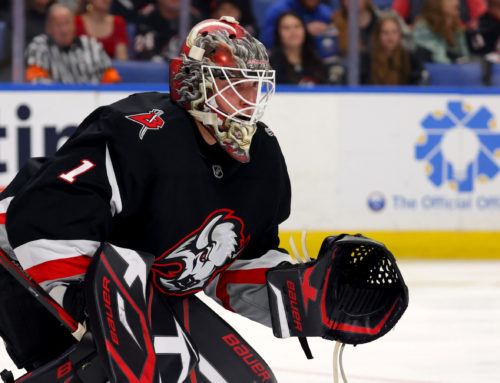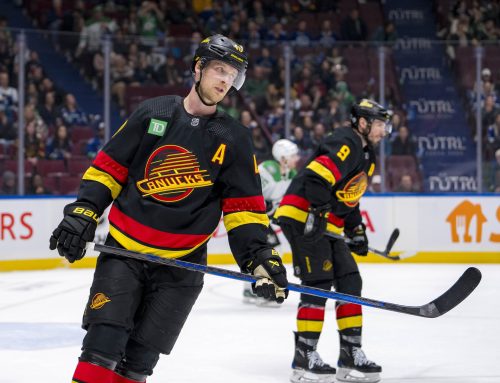Goldipucks and the Three Skaters: J.T. Miller, Anze Kopitar, & Brady Tkachuk
Rick Roos
2019-12-04

As more hockey is played, the temptation becomes to assume skaters will continue to produce at their current scoring rates. But in some cases, appearances can be deceiving, which is what this column seeks to identify. For first time readers or those needing a refresher, the column is a play on the Goldilocks and the Three Bears story, except instead of there being three bowls of porridge I’m covering three skaters and declaring one too hot (i.e., doing unsustainably better than he should), another too cold (i.e., doing unsustainably worse), and a third “just right” (i.e., producing where he should be). I also assign each a rating of 1-10, indicating just how hot (rated 7-10, where 10 is the most unsustainably hot), or how cold (rated 1-4, where 1 is the most unsustainably cold), or how “just right” (rated 4-7, where 5.5 is the most “just right”) he is.
Which three skaters are on tap for this week? J.T. Miller, Anze Kopitar and Brady Tkachuk. Stop here and lock-in guesses as to which is too hot, too cold, and just right. Then read on to see if you scored a hat trick by getting all three correct!
One of the comments on my last Goldipucks column inquired what I thought of Miller. All I can say is ask, and usually, you shall receive!
After landing in Tampa in late 2017-18 and posting 18 points in 19 games, much was expected from Miller going into 2018-19, especially with him having inked a 5 year $26.5M contract that offseason. Sure enough, he emerged with 15 points in his first 20 games; but it was downhill from there, as Miller managed only 47 points in 75 games, with a total that high only because he was still able to command some PP1 time, resulting in 20 PPPts. He was unceremoniously shipped to Vancouver, where once again he’s started strong. Should we brace ourselves for more disappointment? This time I’m thinking no.
When Miller put up those 18 points in 19 games, he was receiving 18:00+ for the first time in his career; and he responded. But even last season when he started nicely with 15 points, his ice time was under 16:00 in more than half those contests. Fast forward to this season, and he’s averaging over 20:00 per game, with the Canucks needing his talent more so than the deeply stacked Lightning did.
Okay, he’s getting solid ice time; but then again so are a lot of skaters who didn’t put up point per game numbers through the first third of the season. What makes his output sustainable? For starters, his team shooting percentage is lower than his last two seasons, plus his OZ%, which had ranged from 43% to 56% in the past four seasons is 61.4%, and that is going to help anyone rack up points. Also, his IPP right now is well lower than in all his Ranger years. Yes, part of that is him having played with poorer talent in New York and better players now in Vancouver; but the key is it will do one of two things – stay low as a function of his line scoring in droves, or it will rise. But either way, the result is points for Miller, erasing some worry about his P/60 rate, which is the only metric that’s running somewhat high for him.
Another encouraging sign is his SOG rate, which is 2.4 per game this season after never once being even two per contest. Yet despite more shots his shooting percentage is at his career mark and his shooting distance is within the 27-28 feet range it’d been in his final three seasons with the Rangers. By shooting more, yet not sacrificing quality, his point total rising becomes even more justifiable.
Lastly, there’s the man advantage, where Miller’s talents were on display even during his tenure in Tampa. This season his share of PP minutes is the highest it’s ever been, and he’s responded with a blistering PPPt pace. With the addition of Quinn Hughes and maturation of Elias Pettersson and Brock Boeser, Vancouver’s PP1 could easily keep humming along, meaning that Miller’s PP rate might drop by only a small amount, if at all.
Given Miller’s jump in ice time yet still spending much of it in the offensive zone, plus playing alongside the best of Vancouver’s skaters both at even strength and on the man advantage, and without his other metrics running high, Miller might be able to maintain or at least come close to maintaining the point per game scoring rate he’s had for this season thus far, which makes his production JUST RIGHT. When the dust settles, I think he’s in for a 75-85 point season, so he gets a rating of 5.25.
After being among the steadiest eddies in all of fantasy hockey, with 65-76 points in six of his first seven full seasons, Kopitar dipped to 52 points in 76 games in 2016-17, only to rebound to a career-best 92 in 2017-18, before cratering again to 60 last season. So far this season, like Miller, he’s been producing point per game numbers. Should we count on the up and down pattern continuing, meaning his stats will stay this strong (or get even better) this season? Sorry Kopitar owners, but the numbers/metrics suggest he’s riding an extended but ultimately unsustainable production wave.
For one, in Kopitar’s 92 point campaign he had 200 SOG, which was nearly 50 more than the average of his prior three seasons. Last season it was back down to 156, and this season it’s on pace to barely rise to 167, still 16% less than what we saw two seasons ago when he was lighting up the scoreboard. Also, 29 of those 92 points in 2017-18 came with the man advantage, and this season so far he’s on pace for a handful of fewer PPPts. Also, when Kopitar exploded for 92 points, the Kings potted 237 goals, up from an average of 205 in the prior five seasons. For 2019-20 thus far, they’re at a projected 212; so unlike in 2017-18, there isn’t a rising tide lifting all boats, including his.
Okay, so maybe Kopitar won’t get 92 points again; but can’t he still be a point per game player despite his SOG and PPT rates and the team’s goal-scoring rate? Probably not; however, there’s are other issues as well. First, his IPP, which for the first nearly third of the season has ranged from 84-89%! Although he’s always been strong in this area, only once in the past five seasons was he above 71% for IPP – you guessed, it, his 2017-18 campaign when he tallied those 92 points. There’s also his OZ% percentage, which, at 43.3%, would be the second-lowest mark of his career. Yes, it was only 46% in 2017-18; but it was also 40% when he had a mere 60 points.
While there’s little doubt Kopitar will surpass his 60 points from last season, not only won’t he rise back to 92 points but given his SOG shortcomings, the team’s lower goal total, his high IPP and low OZ%, he won’t be able to maintain his point per game pace. As such, Kopitar is TOO HOT. I wouldn’t look for a big drop in scoring, especially since Kopitar is a notoriously strong second half scorer and given the points he’s already locked in. Mark him down for 70 points, with a chance at 75 if things go well. As such, he gets an 8.0 rating.
The second of Keith Tkachuk’s sons to make the NHL, last season saw Brady top the 20 goal and 20 assist mark, finishing with 45 points in 71 games (a 52 point full season pace) where 20 of those points came in his final 26 contests. Based on that, expectations were high for Tkachuk coming into 2019-20. But so far his scoring rate is actually lower than what it was last season. Does that mean Brady won’t follow in his brother’s footsteps to see better production as a sophomore? Not so fast…..
In looking at Brady’s stats, it might be easy to miss the fact that he has zero PPPts. Although he didn’t exactly pile on PPPts as a rookie (ten in 71 games), this season he’s averaging 3:01 per game on the PP and has been on the ice for just under 60% of his team’s PP minutes. To put this is better perspective, as I write this Brady has received the 58th most PP Time of all NHL forwards this season, and 88% of those ahead of him have at least a handful of PPPts while the next 25 below him have tallied an average of 5.5 PPPts. So based on PPPts alone, Tkachuk’s scoring is unsustainably low by at least a handful of points.
There’s also what he achieved as a teen rookie in posting 20+ goals, 20+ assists and 180+ SOG, but also under 50 points. Those criteria were met by five others since 2000-01: Sebastian Aho, Steven Stamkos, Dylan Larkin, Taylor Hall, and Pierre-Luc Dubois. Of them, all but Larkin saw their scoring rate increase as a sophomore, with Larkin taking fewer shots and shedding ice time. What were the scoring gains of the other four, each of whom – like Tkachuk – saw his ice time and SOG rates increase? Try 13 points,18 points, 19 points, and, for Stamkos, a whopping 48 points. Looking more at Brady’s SOG rate, it projects to be 295 for this season. That many SOG has been accomplished by someone his age just four times in NHL history, with the point totals of the four being 111, 106, 87, and 73. So while past results don’t dictate future outcomes, these are very positive signs for Tkachuk’s scoring rate increasing, especially since last season already saw Tkachuk’s scoring rate increase with each quarter.
Tkachuk’s other metrics further suggest that improved scoring should be on the horizon, as both his team shooting % and IPP are below what they were as a rookie. Moreover, Tkachuk has just one measly secondary assist for the entire season. And while, of course, someone who shoots as much as he does is more likely to get goals or primary assists, one is too low and means more points are in the cards.
In sum, those of you concerned Brady’s fast train to fantasy stardom was derailing should rest assured it’s only running a bit slow for the moment. Given his unsustainable lack of PP scoring and secondary assists, his extremely high SOG rate, his higher quarter to quarter scoring rate as his rookie season went on, and, yes, also past comparables, all signs point to much higher production between now and the end of the season. In fact, if he plays all 82 games Tkachuk could still hit 60 points, with an outside shot at 65 if he (or his team) catches fire. Thus, he’s TOO COLD and is assigned a 2.0 as a rating.
**
Mailbag questions needed
I’m always in need of questions to answer in my monthly mailbag column. There are two ways for you to get your questions to me – (1) email them to [email protected] with “Roos Mailbag” in the subject line, or (2) send me a private message at the DobberHockey Forums with your question (my username is “rizzeedizzee”.





 CBJ
CBJ PIT
PIT UTA
UTA VGK
VGK CGY
CGY NSH
NSH COL
COL WSH
WSH ANA
ANA DET
DET DAL
DAL FLA
FLA PHI
PHI S.J
S.J OTT
OTT SEA
SEA
